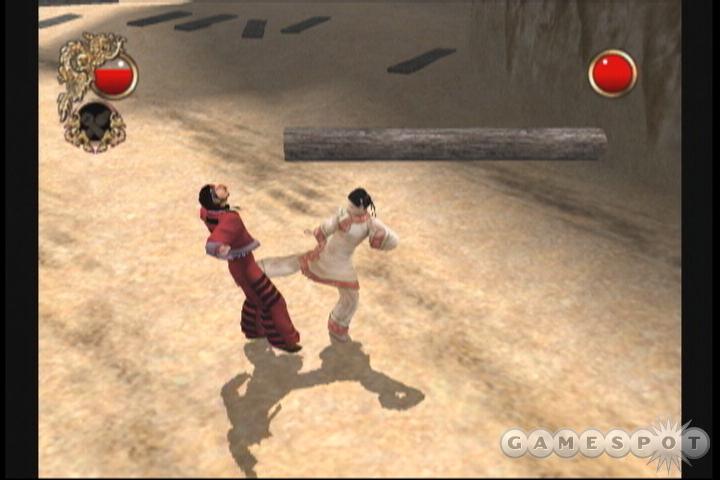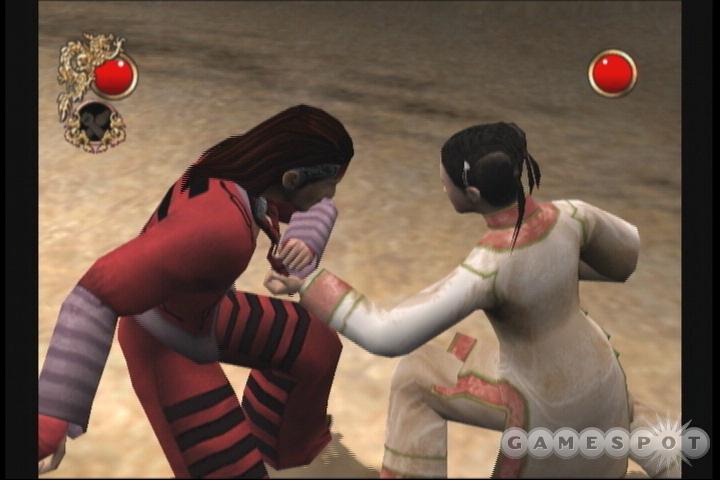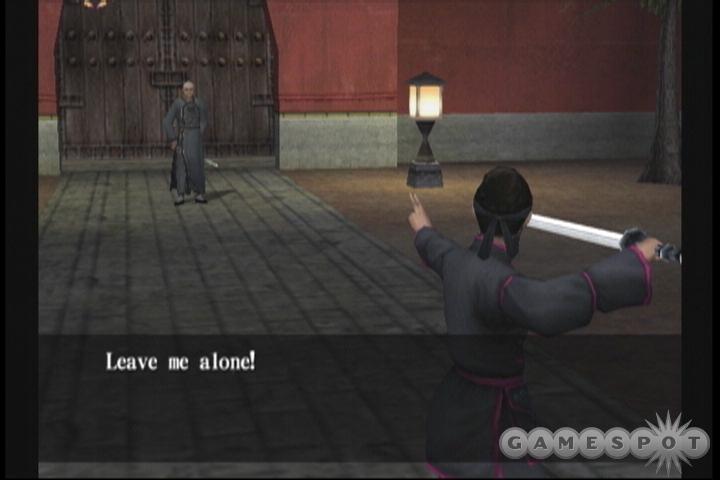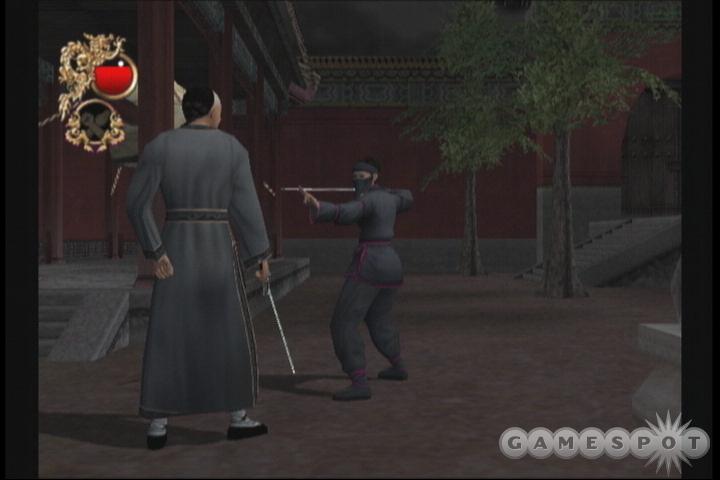When Crouching Tiger, Hidden Dragon was released in the US in 2000, the film could not have been called anything other than an unmitigated success. Wonderfully acted and beautifully directed, Ang Lee's Academy Award-winning film was equal parts martial arts action and fairy tale. It told the story of a mystical sword, known as the Green Destiny, and the characters surrounding it. The cast of characters included: Li Mu Bai, a Zen warrior and possessor of the sword; Shu Lien, his compatriot, love interest, and former lover of a fallen friend; and Jen, the young girl whose stifled, aristocratic upbringing has driven her toward a life of thievery and dishonor. More than two years after the movie's release, Ubisoft, in conjunction with developer Genki, has released Crouching Tiger, Hidden Dragon for the PlayStation 2. The game is generally geared towards the ilk of beat-'em-up games--focusing heavily on combat and lightly on plot. Sadly, while a few decent concepts can be found within, ultimately, repetitive action and a horrid narrative design prevent Crouching Tiger from being anything more than another failed attempt at a movie-to-game translation.

As mentioned before, Crouching Tiger is, at its core, a beat-'em-up style of game where you'll be punching, kicking, and swordfighting your way through a bevy of enemies who all gang up on you at once. You'll also be involved in some duels against feature characters, like the insidious master thief, Jade Fox, and the infamous bandit (and Jen's former fling), Lo "Dark Cloud." Upon first inspection, the combat controls in the game actually seem rather counterintuitive. The four main controller buttons are used for strikes and weapon attacks, while the black and white buttons are used for running and grabbing, and the trigger buttons are used for jumping and combo blocking. Additionally, the left thumbstick button acts as your all-purpose "action button." It's kind of an awkward system, at first, but it's reasonably easy to get used to after a few rounds of combat.
None of the combat is especially innovative, except for one key feature: the combo blocking. The movie's fight sequences were complexly designed by famous fight choreographer Wo Ping Yuen, and in an attempt to mimic his uniquely designed fights, Genki has designed a complementary blocking system that lets you duck, dodge, and flip around enemy attacks by pressing the block button in conjunction with a flashing icon that appears near your life meter. The moves you can pull off are actually quite cool, but the problem with the system is that there's no real challenge to it. The rhythm and pacing of all the combo blocking is exactly the same, no matter who you're fighting against. All you have to do is figure out the right tempo for hitting the block button once, and that's pretty much all she wrote. Still, to Genki's credit, at least it's a cool idea.
Cool ideas aside, the rest of the game's combat elements are all pretty standard. Basic attacks, both strike and weapon-oriented, can be strung together into basic combos, and using the grab button allows you to perform some unique special moves by pressing character-specific button combinations while holding your foe. You can also bounce and fly around, like the characters in the movie. You can run up walls, jump up onto roof tops, and glide around in the air. Eventually, though, all of the action becomes extremely repetitive and stagnant, and, after your umpteenth fight against an onslaught of anonymous bad guys, you're just going to wish the game would end.

Crouching Tiger, Hidden Dragon omits much of the drama and plot from the movie, focusing largely on the most action-packed sections, with occasional CG cutscenes re-created from the movie just to keep the story going. Throughout the game, you'll play as Li Mu Bai, Shu Lien, and Jen. The story is told in sections for each character, with Jen being the first. Each section has five chapters; each chapter is, in effect, a sequence from the film. In some cases, a new sequence has been created specifically for the game. Once you have taken your character through all five chapters, you'll then re-start the story from the beginning, with a new character. The missions and objectives do change from character to character.
Despite this fact, however, you're still going to run into a whole lot of repetition in the game, and, with each new character section, you're likely to find yourself very frustrated with the fact that you've basically already done everything you'll be doing in the coming levels. In fact, some levels are straight-up repeats of previous missions in the game, only with marginally different objectives, and, obviously, a different character. One example is the famous bamboo tree-flying scene from the movie, which, here, has been turned into a somewhat awkward jump puzzle that you'll have to do with both Jen and Li Mu Bai in each's respective sections. Nothing is different about the level, except for the character switch and, in Li Mu Bai's section, a limited amount of time in which to complete the level. The game is rife with these types of situations, and it wears thin very quickly.
Another big problem is that nearly every level in the game contains at least one heavy dose of backtracking. Practically every mission includes at least one part where you'll need to run to one place, perform a meaningless task, and then run back the way you came. You then run to another section on an alternate path, fight a bunch of guys, and then run back to the place you just came from to perform another meaningless task until you can get to the end of the level. The only way to discern exactly where you're supposed to be going at any given time is by searching for a pair of torches that appear at every entrance and exit. If the torches are lit in blue, that's the path you want to take. Green-lit torches signify where you just came from, and unlit torches indicate a blocked path. Thankfully, these torches are pretty obvious wherever you go; otherwise you'd be backtracking even more than you already have to.

Even more perplexing than the game's heavy reliance on backtracking is the game's peculiar list of mission objectives. Most levels just require you to defeat a lot of bad guys before you can move on, but some missions involve a lot of oddly placed platform-like elements, like ropes that you have to dangle from while sidling across a crevice and scalding steam that spews from a lava pit that can only be navigated through in narrow time windows. There's also a seemingly endless array of irritating jump puzzles. Nearly every climatic duel in the game also suffers from odd design, as you'll rarely ever actually have to beat your opponent so much as you will have to perform a certain number of combo blocks or special moves to advance. It's all very strangely set up, and, fundamentally, it just doesn't lend itself to being much fun.
If you do manage to make it through the whole game, you will be rewarded for your patience with some unlockables. As you play each level, you're graded on how well you perform in such categories as combo attacks, combo blocking, and number of continues used. If you score an "A" during a level, you'll unlock a scene from the movie. Once you've actually beaten the game, you'll unlock a special mode that lets you access all your unlocked items, including an added story section where you can play as Lo. All the game's cutscenes and unlocked movie clips, a couple of minigames, concept art, and the like, are also unlocked. The game additionally contains three different endings depending on how you progress. While all of this is well and good, the fact remains that you'll actually have to play through the game multiple times to unlock everything, and, really, you'll be lucky if you can stand playing through it one full time.
Crouching Tiger, Hidden Dragon was a visually stunning movie, while Crouching Tiger, Hidden Dragon the game, on the other hand, is anything but. In fact, nothing about the game looks especially good. There's some extremely drab, redundant environments, a very limited roster of cyclical enemies, and a decisively lackluster list of character animations. The game's camera never sets up a proper angle for the action, so you'll have to constantly babysit it to get a good view. The game's CG cutscenes aren't anything special, and, really, considering the amount of footage contained in the game, if the developers had just tweaked the story a bit less and made it flow more like the movie, they could have just done away with the CG stuff altogether. Granted, the game's visuals aren't all bad, as the in-game models for the primary characters do look decent enough, and each level does contain some destructible elements. However, none of these facts make up for the fact that, visually, there's just nothing impressive here. The Xbox version of the game is a pretty typical port, in that it features a marginally cleaner look, but it's mostly identical to the previously-released PlayStation 2 version.

The game's audio has its moments, but, like the visuals, it isn't very good, generally speaking. As in the film, all of Crouching Tiger, Hidden Dragon's voice work is done in Chinese with English subtitles. While this is a nice touch, the voice actors who perform the primary roles don't sound like anything even vaguely resembling the original actors, and none of them deliver much in the way of an emotional performance. In-game sound effects are pretty spare, with a lot of re-used and generic-sounding punching and sword-slashing effects. The game also repeats the same hackneyed groans from enemies as you beat upon them. The one truly nice aspect of Crouching Tiger's audio is that it features much of the movie's original score. The music is genuinely pleasant to listen to, but, unfortunately, it's simply wasted here trying to provide atmosphere to a game that simply doesn't have any.
Ultimately, Crouching Tiger, Hidden Dragon is yet another example of a movie-based game that does little--if any--justice to its source material. Save for the combo blocking system, the gameplay doesn't do anything a thousand other, identical games haven't done before, and the frustratingly repetitive level and mission designs further solidify Crouching Tiger as a mediocre effort, at best. Fans of the movie should be even more strongly advised against picking up the game, as the plot and dialogue have been hacked up to the point where little of the movie's narrative is even recognizable. Additionally, none of the game's unlockables enrich the experience at all--especially when you consider that the unlockable movie clips are far better-served on the Crouching Tiger DVD. To watch your favorite scenes on the DVD, you won't have to play through a mediocre game. In the end, you can simply chalk Crouching Tiger, Hidden Dragon up as an interesting idea for a game that just didn't work.